Creative Container Designs That Welcome Summer
The showiest season is the time to try everything
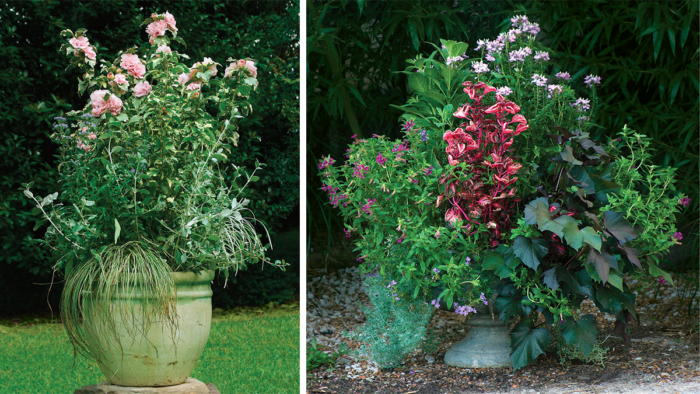
I have a passion for green things—and all things related to green things. Plant and container specimens line my greenhouse shelves, carport, and driveway. Come summer, I put all worries of frost and cold weather aside and start pairing things up from my collection.
Summer is the time to try everything. Nothing is off-limits: Tropicals, succulents, foliage, and flowers are all available for the taking. I create safe, easy combos, but the challenging ones are often the most rewarding. If I attempt a container experiment and it doesn’t play out just how I planned, there are always plenty of other plants available to start over with and to try again.
Many of my plants have lived in containers for years with only periodic repotting. Some of my favorites may never go in the ground but, rather, adorn different places on my patio each year. This is why summer is meant for container combos; you can rearrange recycled plants and make end-of-season cleanup a snap by bringing your favorite cold-sensitive combos indoors as the weather turns cool.
A delicate spiller softens a dramatic combo

I look for reliable, flowing spillers to complement bold plants. Creeping wire vine, a sturdy, vigorous creeper, blankets this pot. I added the broad, dark leaves of cordyline to separate and define colorful and dominant plants, like the large-leaved begonia. The solid color and texture of the foliage plants elevate the impatiens’ vibrant blooms to a higher status. The result is a slightly tropical look, even in shade.
- ‘Dr. Brown’ cordyline (Cordyline fruticosa ‘Dr. Brown’, USDA Hardiness Zone 11)
- Begonia (Begonia cv., annual)
- Painted Paradise™ Red New Guinea impatiens (Impatiens Painted Paradise™ Red, annual)
- Dazzler™ Rose impatiens (Impatiens walleriana Dazzler™ Rose, annual)
- Creeping wire vine (Muehlenbeckia axillaris, Zones 8–10)
Companion plants play up the focal point

You can’t pass by Tiger Eyes™ sumac without stopping to take another look. There’s something about its tall stature, deeply serrated leaves, and lime green color that everyone loves. Its fan-shaped growth resembles the appearance of a low, brilliantly colored palm tree. In this combo, the dark foliage and vibrant yellow and red blooms of the companion plants emphasize the lushness of Tiger Eyes™.
- Tiger Eyes™ sumac (Rhus typhina ‘Bailtiger’, Zones 4–8)
- ‘Red Carpet’ Joseph’s coat (Alternanthera ficoidea ‘Red Carpet’, Zones 9–11)
- Golden shrimp plant (Pachystachys lutea, Zones 10–11)
- Shrimp plant (Justicia brandegeeana, Zone 11)
Golden foliage glows with rich appeal
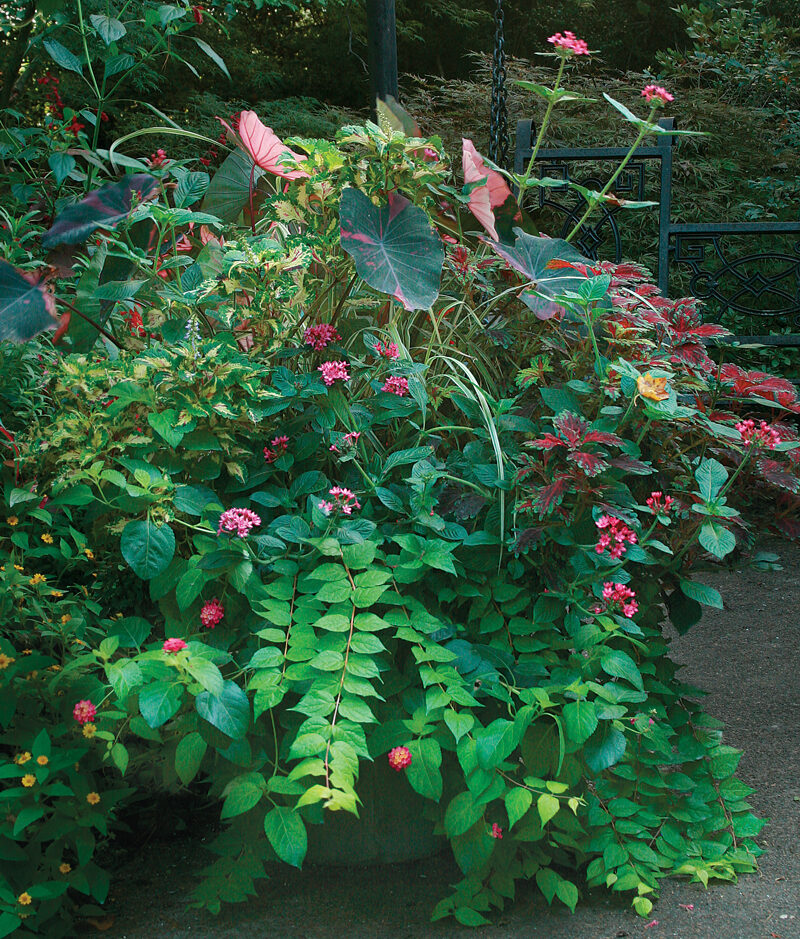
I love shrubs with gold-tinted foliage that have year-round appeal. They add a touch of brightness to any combo. I use these colorful bushes in containers for a year or two before they grow too large and need to be moved to the garden. In this mix, the frost-hardy foliage of Dream Catcher™ beautybush spills out from beneath some of my favorite annuals and perennials. As the cool days progress, the foliage will turn from lime tinted with gold to a deep shade of gold with hints of orange.
- Dream Catcher™ beautybush (Kolkwitzia amabilis ‘Maradco’, Zones 4–8)
- Pentas (Pentas lanceolata cv., annual)
- ‘Red Hot Rio’ coleus (Solenostemon scutellarioides ‘Red Hot Rio’, Zone 11)
- Elephant’s ear (Colocasia esculenta* cv., Zones 8–11)
- Coleus (S. scutellarioides cv., Zone 11)
*See invasive alert below.
Highlight soft, sweet petals with dark mates

Summer flowers attract hummingbirds and butterflies, so I often create containers that feature flowering nectar plants along with ones grown purely for their foliage. I use dark-colored leaves to dramatically outline my best bloomers because flowering plants often don’t have the most interesting foliage. I also alternate small leaves and bold leaves to add distinction among foliage plants.
- ‘Sweet Caroline Bewitched Purple’ sweet potato vine (Ipomoea batatas ‘Sweet Caroline Bewitched Purple’, Zone 11)
- ‘Cha Cha’ cuphea (Cuphea llavea ‘Cha Cha’, Zones 8–10)
- Senorita Rosalita® cleome (Cleome ‘Inncleosr’, annual)
- ‘Northern Lights Lavender’ pentas (Pentas lanceolata ‘Northern Lights Lavender’, annual)
- ‘Amazon Sunset’ lotus vine (Lotus ‘Amazon Sunset’, annual)
- Babylon® Light Blue verbena (Verbena × hybrida ‘Dulcena’, annual)
- ‘Brilliantissima’ iresine (Iresine herbstii ‘Brilliantissima’, annual)
Shrubs aren’t just for landscapes

Blooming shrubs are durable, hardy members of my container-garden family. And when a shrub also has colorful, attractive form and foliage, its value triples in my eyes. The beautiful powder-puff pink blooms and variegated foliage of this Sugar Tip® rose of Sharon persist all summer, and the whole combo utilizes waterwise shrubs and perennials rather than thirsty annuals—a great attribute where water shortage and maintenance is an issue.
- Sugar Tip® rose of Sharon (Hibiscus syriacus* ‘America Irene Scott’, Zones 5–9)
- Petit Bleu™ blue-mist shrub (Caryopteris × clandonensis ‘Minibleu’, Zones 5–9)
- ‘Amazon Mist’ sedge (Carex ‘Amazon Mist’, Zones 7–10)
- Bush germander (Teucrium fruticans, Zones 8–9)
- ‘Silvery Sunproof’ liriope (Liriope muscari ‘Silvery Sunproof’, Zones 6–10)
You can’t drown a water-loving plant
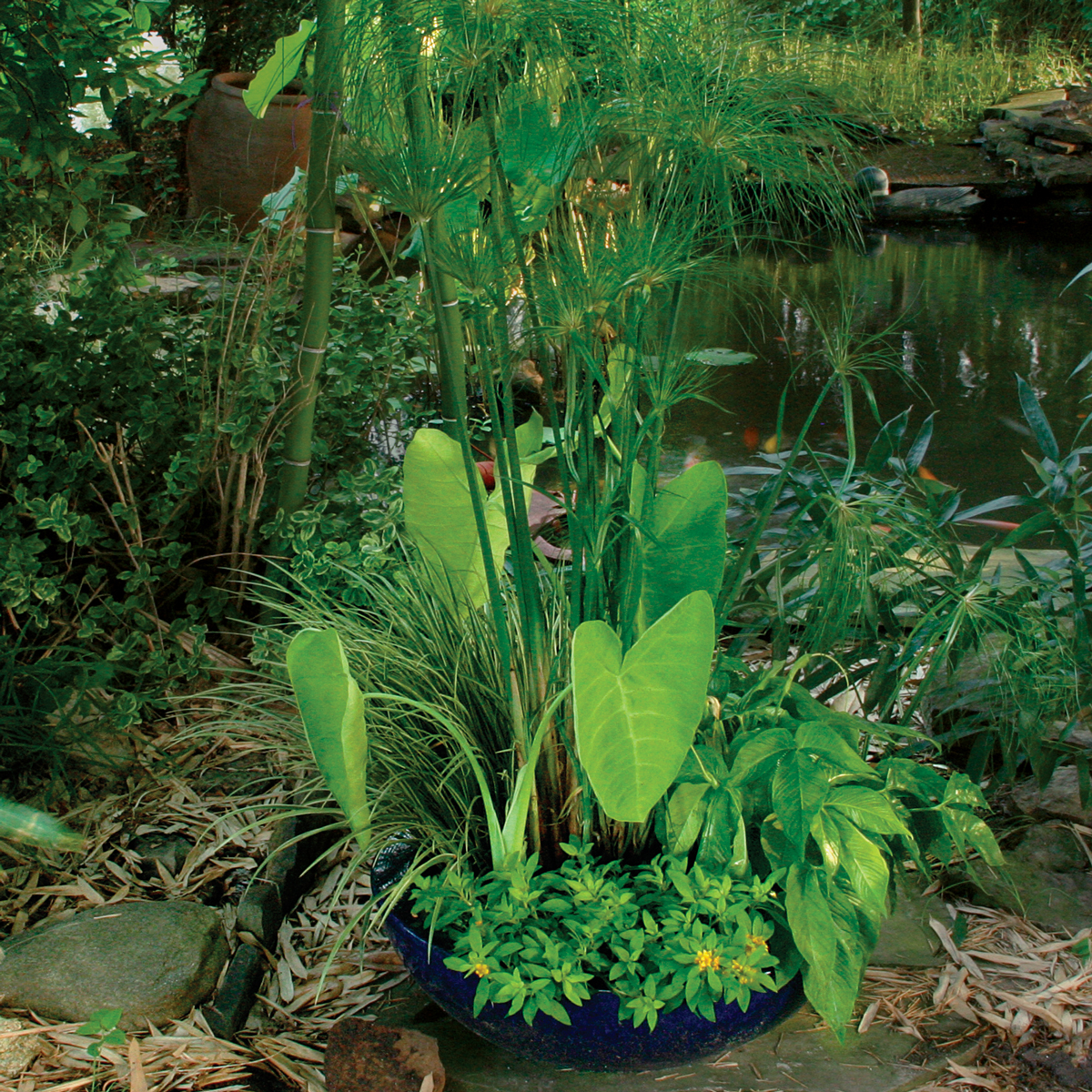
Water gardens are easy when they’re in a container. In this watertight bowl, I put all sorts of my favorite moisture-loving plants together: some short and full, others tall and elegant. I keep most of the weighty plants low to highlight the thin, taller stems. This is also a low-maintenance container. Filled with a gallon or so of water, you can go on a short vacation and not worry about the plants surviving while you’re gone.
- King Tut® papyrus (Cyperus papyrus King Tut®, annual)
- ‘Lime Zinger’ elephant’s ear (Xanthosoma ‘Lime Zinger’, Zones 8–11)
- Sundew Springs™ lysimachia (Lysimachia congestiflora Sundew Springs™, Zones 7–11)
- Variegated sweet flag (Acorus gramineus ‘Variegatus’, Zones 6–9)
- Voodoo lily (Pinellia tripartita, Zones 5–10)
Every garden needs a blue container

It’s easy to fall in love with a blue pot, perhaps because true blues are hard to find in nature. All I really know is that nearly every plant I’ve tried looks great in a blue container. With bamboo and lots of lush greens around my koi pond, the larger leaves of a dwarf elephant’s ear are perfect for this cobalt blue pot. The limey golden foliage of oregano spills from the container’s edge like a strand of lights and finishes off this arrangement.
- Dwarf elephant’s ear (Alocasia odora ‘California’, Zones 8–11)
- Orange hair sedge (Carex testacea, Zones 8–9)
- Golden oregano (Origanum vulgare ‘Aureum’, Zones 4–9)
- Variegated potato vine (Solanum jasminoides ‘Variegata’, Zones 9–11)
- Serena White® angelonia (Angelonia angustifolia Serena White®, annual)
- Lantana (Lantana camara* cv., Zone 11)
*See invasive alert below.
Low maintenance doesn’t mean low impact


Cool colors and soft textures mingle in this low-maintenance conifer and ornamental oregano mix designed by a friend of mine: University of Tennessee horticulturist Jason Reeves. In the background, a rich-colored coleus provides a shot of complementary color for the green tones of the plants in front. This beautiful and durable pairing of containers conveniently line the walk into a public building, where the folks inside can better view them.
- ‘Barry’s Silver’ Lawson false cypress (Chamaecyparis lawsoniana ‘Barry’s Silver’, Zones 5–9)
- Cuban oregano (Plectranthus amboinicus, Zones 10–11)
- ‘Lemon Twist’ variegated plectranthus (Plectranthus ‘Lemon Twist’, Zones 10–11)
- ‘Alabama sunset’ coleus (Solenostemon scutellarioides ‘Alabama Sunset’, Zone 11)
Green and white display foliage at its best

Green is nature’s best shade. This soothing mix of green-and-white variegation plays together, creating an almost metallic feel. A sturdy, slate gray container picks up on the darker shades, while repetitious patterns of white veins, dots, and lines jump out of the arrangement. Variegated corn is the thriller of this combo, while the peacock moss spills down the sides.
- ‘Polly’ African mask (Alocasia × amazonica ‘Polly’, Zones 10–11)
- ‘Snow Capped’ begonia (Begonia ‘Snow Capped’, Zone 11)
- ‘Winning Streak’ variegated corn (Zea mays ‘Winning Streak’, annual)
- Peacock spikemoss (Selaginella uncinata, Zones 6–9)
- ‘Silver Falls’ dichondra (Dichondra argentea ‘Silver Falls’, Zones 10–11)
- English ivy (Hedera helix* cv., Zones 5–11)
Playful colors command attention

“Chocolate and Cherries” is the color scheme of these unlikely partners. The design starts off dark and lightens as you reach the top, ending in a whisper of flowers. Large leaves mirror the weight of the metallic container, and fine foliage softens the edges. The flowers of dwarf crape myrtle are an added bonus because the foliage is lush enough to grab your attention even when the plant isn’t in bloom.
- Razzle Dazzle® Cherry Dazzle® dwarf crape myrtle (Lagerstroemia ‘Gamad I’, Zones 6–9)
- Copperleaf (Acalypha wilkesiana cv., Zones 10–11)
- African mallow (Anisodontea capensis, Zones 8–9)
- ‘After Dark’ Australian willow myrtle (Agonis flexuosa ‘After Dark’, Zones 10–11)
- ‘Grape Expectations’ coleus (Solenostemon scutellarioides ‘Grape Expectations’, Zone 11)
Design tips

Lining terra-cotta pots saves water
Terra-cotta containers can certainly be a challenge to keep watered during the hot summer months, but lining the inside of a pot with a plastic bag can cut down on evaporation from the sidewalls. Be sure to provide drainage by cutting plenty of holes in the bottom of the bag.
Ready-to-go containers are great for busy gardeners
An easy and time-saving way to fill a pot is to find a mixed container or hanging basket at a local nursery that has plants you really like in it. Transfer it to a larger container of your own and then add to the mix any other plants you find appealing.

Wild colors add flair to lush combos

I wasn’t quite ready to plant this delicate Chinese parasol tree in the ground, so I housed it in this container to protect it from any accidents, like skinning the trunk with a mower or weed whacker. The tree, barely a year old, acts as a canopy in this combo. Its outstretched green leaves create dappled shade for the remaining members of the container. The citrus colors of hibiscus and golden shrimp plant create a vibrant, showy underplanting, while the golden oregano drapes over the container edge and brightens the pale cream color of the pot.
- Chinese parasol tree (Firmiana simplex*, Zones 7–11)
- Golden shrimp plant (Pachystachys lutea, Zones 10–11)
- ‘Katie’ wild petunia (Ruellia brittoniana* ‘Katie’, Zones 8–11)
- ‘Pride of acadiana’ Cajun hibiscus (Hibiscus rosa-sinensis ‘Pride of Acadiana’, Zone 11)
- Golden oregano (Origanum vulgare ‘Aureum’, Zones 4–9)
*See invasive alert below.
Colorful, lengthy bloomers create a tropical paradise

Golden oxalis casts a warm glow, outlining and cradling this arrangement while blending several citrus colors together. Exotic, tropical-looking flowers burst from plants intermingled among the blades of orange hair sedge. Best of all, the shrimp plant and ‘Summer Candle’ firecracker flower bloom all summer long.
- ‘Yellow queen’ shrimp plant (Justicia brandegeeana ‘Yellow Queen’, Zones 10–11)
- Molten Lava™ oxalis (Oxalis vulcanicola Molten Lava™, annual)
- Orange hair sedge (Carex testacea, Zones 8–9)
- ‘Summer Candle’ firecracker flower (Crossandra infundibuliformis ‘Summer Candle’, Zones 10–11)
- Golden Mexican heather (Cuphea hyssopifolia ‘Aurea’, Zone 11)
- Variegated vinca vine (Vinca major* cv., Zones 7–9)
*See invasive alert below.
Colorful foliage and flowers are a powerful mix
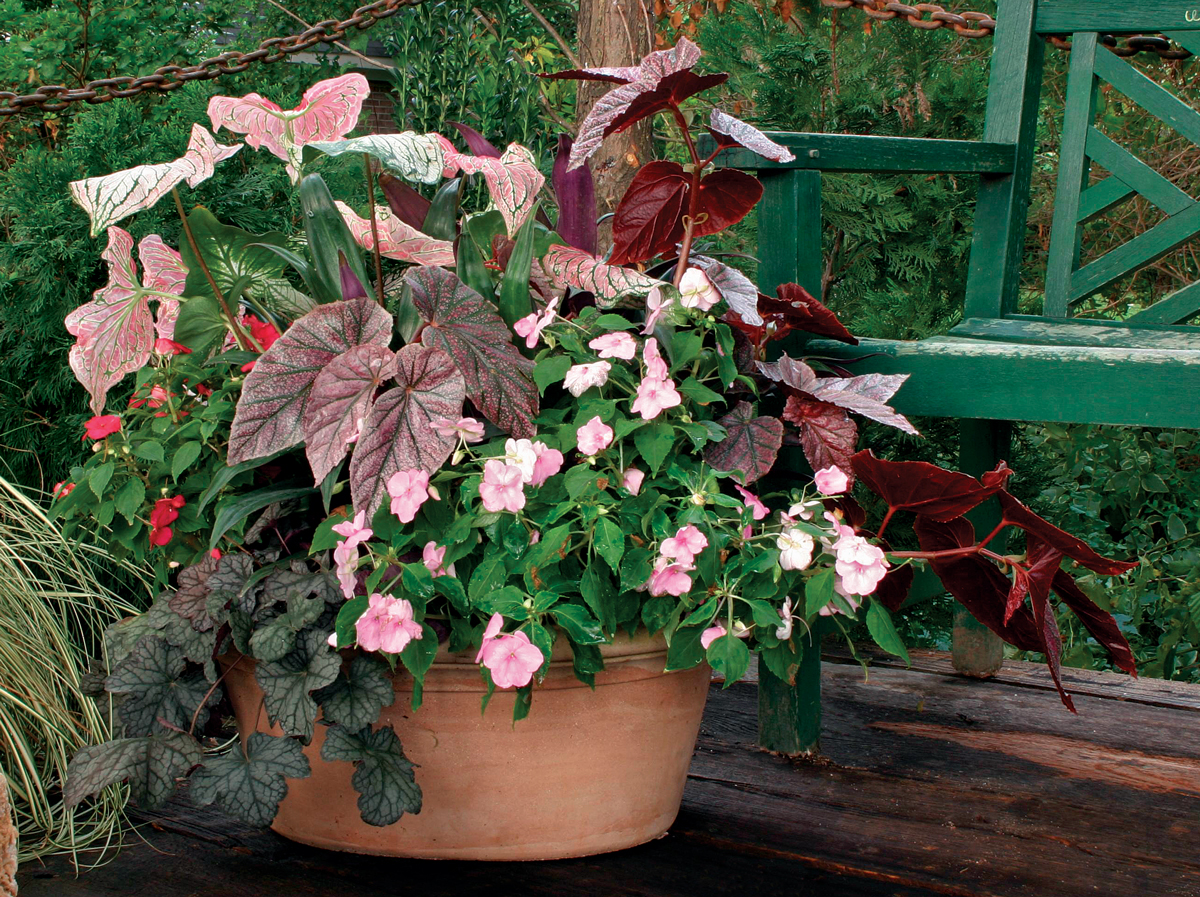

Soft yet striking, this pink-toned mix is a pleasing and relaxing thing to see on my deck at the end of a long day. Begonias of similar color entice a closer look inside the arrangement. The silver and dark plum ‘Silver Scrolls’ heuchera gives the mix weight near the pot’s edge, tying all the shades of pink together.
- ‘Thai Beauty’ caladium (Caladium bicolor ‘Thai Beauty’, Zones 10–11)
- ‘Sinbad’ cane begonia (Begonia ‘Sinbad’, Zone 11)
- Angel wing begonia (Begonia coccinea, Zone 11)
- ‘Silver Scrolls’ heuchera (Heuchera ‘Silver Scrolls’, Zones 4–9)
- Super elfin™ Mix Pastel impatiens (Impatiens walleriana Super Elfin™ Mix Pastel, annual)
Blend shades of color for a dazzling trio

It only takes a short stroll outside to see how many color hues exist in nature. I often pair plants by mirroring hints of other colors found in green foliage. Shades of green, blue, and yellow play off each other well in this easy-to-grow arrangement. Even the spotted leopard plant will produce bright yellow flowers in summer. Using a large ceramic pot like this can be a little heavy, so I usually fit a lightweight liner inside or place a false bottom in the pot to lighten the load.
- Peacock spikemoss (Selaginella uncinata, Zones 6–9)
- Spotted leopard plant (Farfugium japonicum ‘Aureomaculatum’, Zones 7–8)
- ‘Laurentii’ mother-in-law’s tongue (Sansevieria trifasciata ‘Laurentii’, Zone 11)
Rich reds burn bright with black contrasts
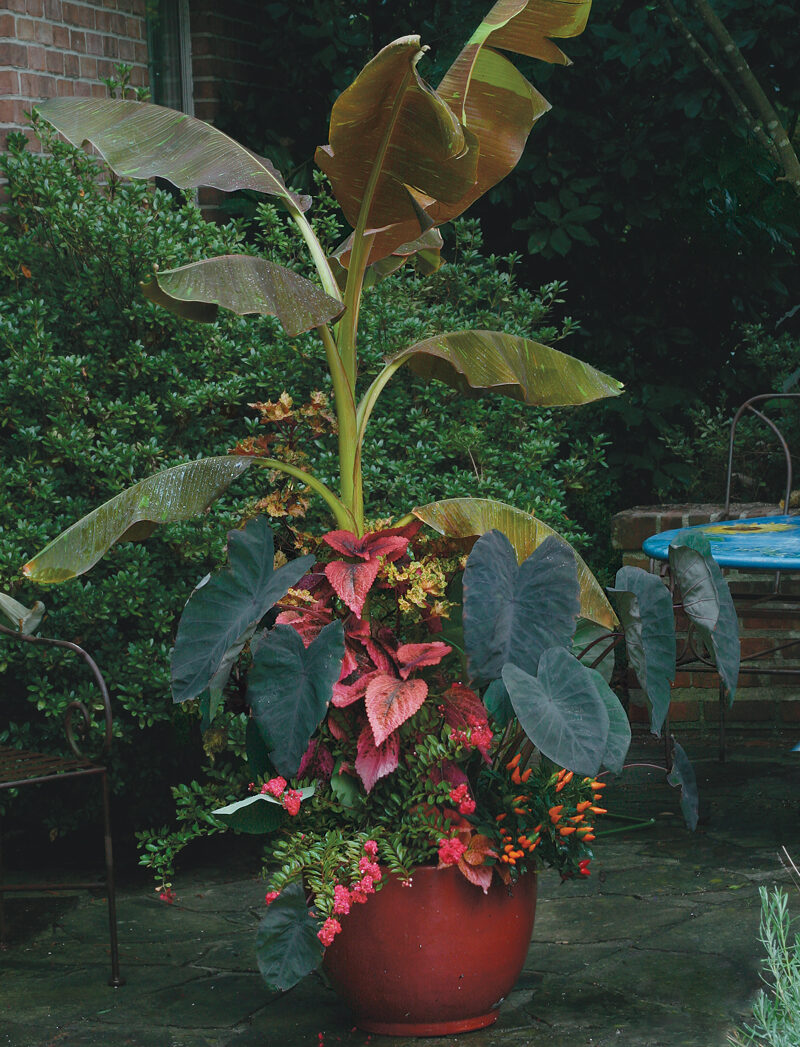
I like to use ‘Siam Ruby’ banana in my containers because it doesn’t seem to be as vigorous as other bananas, leaving room for complementary plants. Large leaves counterbalance the size of this tropical plant. ‘Black Magic’ elephant’s ear fits the bill with its big, bold leaves. To keep the arrangement from looking too chunky, brightly colored coleus, hot pepper, and fine-textured foliage fill in the remaining open spots.
- ‘Siam Ruby’ banana (Musa acuminata ‘Siam Ruby’, Zones 9–11)
- ‘Black Magic’ elephant’s ear (Colocasia esculenta* ‘Black Magic’, Zones 8–11)
- Mariposa™ coleus (Solenostemon scutellarioides Mariposa™, Zone 11)
- Razzle Dazzle® Cherry Dazzle® dwarf crape myrtle (Lagerstroemia ‘Gamad I’, Zones 6–9)
- ‘Explosive ember’ ornamental pepper (Capsicum annuum ‘Explosive Ember’, annual)
Cactus adds a unique touch to a subtle mix

This pot, created by Jason Reeves, displays a bit of southwestern style in an otherwise standard mix. An unusual red cactus, discovered during a plant-buying trip, makes its home cascading out of the side. Its bright color and unique foliage wake up this cool mix, the red popping out like a colorful ribbon tied to the front.
- Red mistletoe cactus (Pseudorhipsalis ramulosa, Zone 11)
- Diamond Frost® euphorbia (Euphorbia ‘Inneuphdia’, Zones 10–11)
- ‘Lemon & Lime’ coleus (Solenostemon scutellarioides ‘Lemon & Lime’, Zone 11)
Tall, sturdy grasses elevate this combo

When I saw this big, bodacious grass growing in Georgia, I had to have it. ‘Princess’ napier grass can reach 4 feet tall, as high as some dwarf bananas. Added to the height of this earth-tone pot, it makes a wonderful vertical statement, along with the big, bold coleus. The vertical structure will stay tall and strong because ‘Princess’ napier grass doesn’t flop like other grasses. This combo is also low maintenance because few of the plants require much trimming and ‘Princess’ is an infrequent bloomer.
- ‘Princess’ napier grass (Pennisetum purpureum* ‘Princess’, Zones 8–11)
- ‘Alabama Sunset’ coleus (Solenostemon scutellarioides ‘Alabama Sunset’, Zone 11)
- Golden shrimp plant (Pachystachys lutea, Zones 10–11)
- ‘Sedona’ coleus (S. scutellarioides ‘Sedona’, Zone 11)
- ‘Sweet Caroline Bewitched Purple’ sweet potato vine (Ipomoea batatas ‘Sweet Caroline Bewitched Purple’, Zone 11)
- Himalayan honeysuckle (Leycesteria formosa, Zones 7–9)
Use contrasting, shapely foliage as the main player

Fooling around with foliage is my favorite pastime. Even well-known, leafy houseplants can double as colorful outdoor-container components in shade. ‘Prince of Orange’ philodendron is the focal point in this beautiful terra-cotta pot, complementing its color. Mother-in-law’s tongue makes a dynamic linear accent, rising above the other foliage. A little splash of color from the blooms of kalanchoe is icing on the cake.
- ‘Prince of Orange’ philodendron (Philodendron ‘Prince of Orange’, Zone 11)
- ‘Laurentii’ mother-in-law’s tongue (Sansevieria trifasciata ‘Laurentii’, Zone 11)
- ‘Macho’ fern (Nephrolepis biserrata ‘Macho’, Zones 9–11)
- ‘Forever Midi Orange Glow’ kalanchoe (Kalanchoe ‘Forever Midi Orange Glow’, Zone 11)
- ‘Troy’s Gold’ plectranthus (Plectranthus ciliatus ‘Troy’s Gold’, Zones 10–11)
Create balance by pairing like-size plants

Several of my favorite succulents have found a home together in this earth-tone mix. The ‘Giant Glutinosum’ aeonium was beginning to get so big that I needed several large rosettes of succulents to balance the visual weight of this arrangement. The completed combo showcases both tall and short succulent specimens, while the shades of yellow, green, pink, and blue add color that you might not expect to see in a water-wise combo.
- ‘Giant glutinosum’ aeonium (Aeonium ‘Giant Glutinosum’, Zones 9–11)
- Sedum (Sedum cv., Zones 6–11)
- Echeveria (Echeveria sp., Zone 11)
Different growing conditions aren’t deal breakers

Who says that all the plants in a mix have to have the same growing conditions? Plants sometimes astound me with their adaptability to various conditions. This combo, designed by Jason Reeves, pairs a mixture of plant needs, from the moisture-loving ajuga to the semi-drought-tolerant Chinese mahonia. If the mix looks good, I say go for it—because in the end, it’s all about what you like. But do expect your friends to stop by and gawk adoringly.
- ‘Tricolor’ cordyline (Cordyline fruticosa ‘Tricolor’, Zone 11)
- ‘Chocolate chip’ ajuga (Ajuga reptans* ‘Chocolate Chip’, Zones 3–9)
- ‘Trailing burgundy’ coleus (Solenostemon scutellarioides ‘Trailing Burgundy’, Zone 11)
- ‘Caramel’ heuchera (Heuchera ‘Caramel’, Zones 3–8)
- Chinese mahonia (Mahonia fortunei, Zones 8–9)
*See invasive alert below.
A hot summer calls for cool techniques
For containers not only to survive but also to thrive in the summer months, you need to take a few precautions, which will make life a lot easier. Adding high-quality potting media, top-dressing in areas of hot sun to cut down on evaporation, and watering and fertilizing routinely are the basic necessities for good growth. This level of attention may make you feel like you’ve just adopted a new pet—and rightly so. Plants need attention, but you’ll be rewarded with great performance.
Make container design easy by choosing the main players first

Whether I’m trying to achieve a formal atmosphere or a lively, tropical one, I look for my main players first. The plants I choose as focal points usually have remarkable attributes that can intensify the impact of a matching pair of urns or a single, large container. I combine plants that have large or long leaves with rich-colored or lush green foliage to set the theme. For designs that need a little something extra, I employ companion plants to finish the look. Hold up a plant and inspect its color, texture, and size to determine if it will work as a stand-alone specimen or if it needs friends.
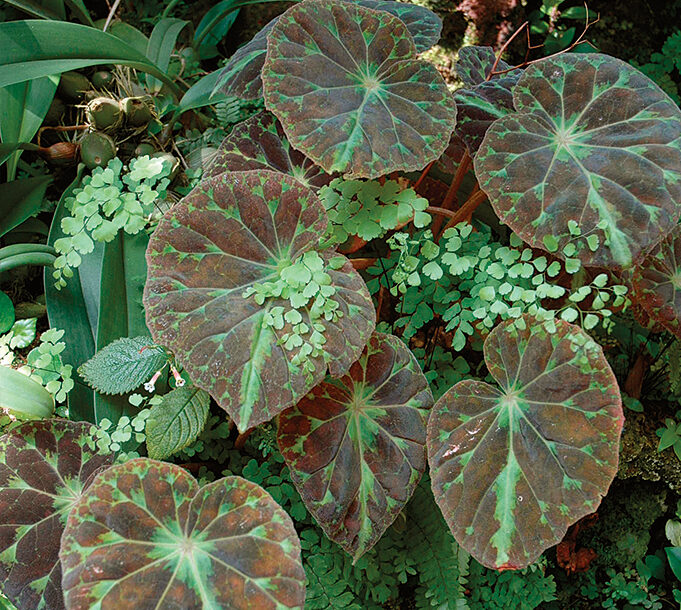
Use fine foliage to separate large leaves
Soft, tiny, or ferny foliage interspersed among large, dominant leaves is the glue that holds all the foliage together. Whether you use the thriller/filler/spiller design technique, the planting-in-odd-numbers technique, or the color-theory approach, your main focus should be using complementary textures. That will make it easy to create exciting container combinations—even if they’re simply green.

You can fill your pot to the brim if you pick plants with similar needs
Visitors to my greenhouse often ask me how many plants they can safely put in a pot. The answer depends on how much money you have. In all seriousness, plants grow until they touch and mingle anyway, so filling a pot is quite acceptable. Just make sure that all the plants have compatible growing habits and that one eager grower won’t take over the others. You can usually find all this information on a plant tag, but be sure to ask questions at the nursery if you’re picking a plant that doesn’t include growing requirements.
A sandy topdressing holds in moisture

If your fully grown pots dry out so fast that watering them becomes a major chore, try mulching with some handfuls of a sand, bark, and granular fertilizer mix. When this combo is spread evenly on top and watered, the sand sifts down into the root area and helps hold in extra moisture. I also use an all-natural, granular fertilizer called Plant-tone, by Espoma, to provide a variety of nutrients that won’t leach out with watering (every time you water, you are rinsing soluble fertilizer out).

Trim plants to promote shapely new growth
Right when summer peaks and all our containers are looking full and lush, it’s time to think about cutting some plants back a little. Verbena and lantana, for instance, benefit from regular pinching throughout the summer. Impatiens often grow so fast that they require clipping back two or three times during the summer.
When you cut, go back to a joint or node that has a side branch or has new growth emerging. This helps avoid “blind eyes” that won’t produce any new growth. Be sure to gently fertilize your containers after cutting to ensure that the new growth comes out strong and healthy. This is also a good time to check for pests, being sure to turn the leaves over to inspect the undersides.
*These plants are considered invasive in some areas. Please check invasiveplantatlas.org or your state’s list of invasive plants for more information.
Fine Gardening Recommended Products

The Crevice Garden: How to make the perfect home for plants from rocky places
Fine Gardening receives a commission for items purchased through links on this site, including Amazon Associates and other affiliate advertising programs.

Morvat Heavy Duty Brass Y-Valve
Fine Gardening receives a commission for items purchased through links on this site, including Amazon Associates and other affiliate advertising programs.
- Fitted with US Standard NH 3/4" threads for use with most water source fittings
- Screw the 2 way splitter adapter by hand or wrench with the updated hexagonal top connection. The 360° rotatable swivel connection attaches to any water source.

ARS Telescoping Long Reach Pruner
Fine Gardening receives a commission for items purchased through links on this site, including Amazon Associates and other affiliate advertising programs.








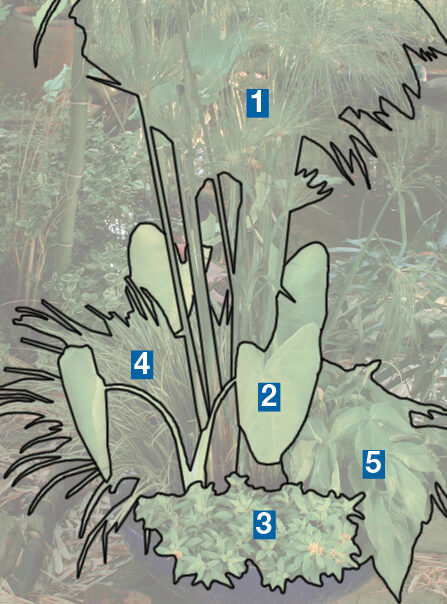
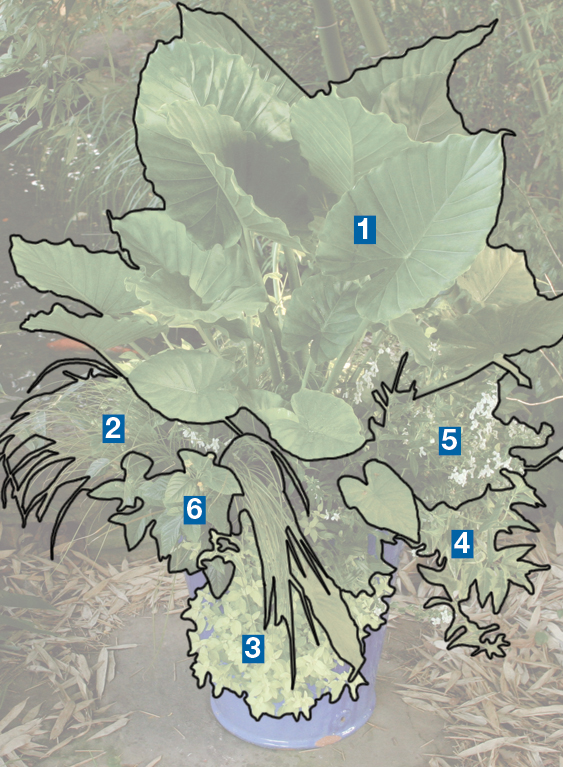
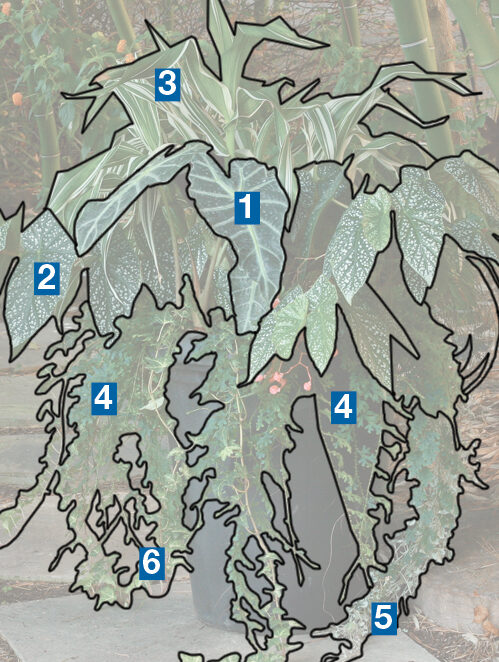














Comments
Log in or create an account to post a comment.
Sign up Log in